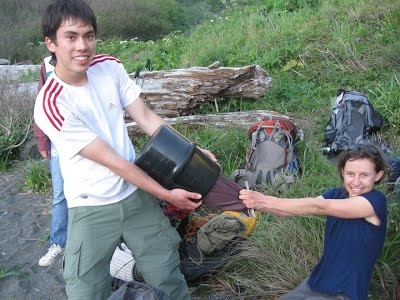Stanford Outdoors Presidency
I became involved in the leadership for outdoor activities on-campus towards the end of the first year I was serving as an instructor for the Outdoor Education Program. At the time, there were seven clubs under an umbrella organization called Stanford Outdoors. At first, I was involved because the club I was part of was re-thinking its future directions. However, on many levels the campus was in the process of trying to re-think the direction of how outdoor activities would be structured on-campus. The two melded together and I became president of Stanford Outdoors.
Flyer from the winter backcountry film-festival.
The challenge of the year was to address the issues around the future direction of the clubs while ensuring that the clubs were able to function as normally as possible. Since being part of a transition year means a large workload one of the first and most important steps I took as president was increasing the size of the leadership team from three people to seven people. Much of my task was acting as an interface between the seven different clubs and the university. The large leadership team let me focus on the role being at the interface, while my event coordinator could make sure that we still were running a fall and spring BBQ. This worked well enough that we were even able to run a backcountry film festival in the winter.
There were many stakeholders in determining the structure of outdoor activities on campus. I served on a close to weekly committee that had representatives from four different departments on-campus. The committee had a two-fold purpose. First, the committee considered the future direction of the outdoors programs. Second, the committee reviewed proposals for trips run by the seven different clubs. The two purposes required different leadership skills.
When the committee considered the issue of the future direction of outdoor activity on-campus, much of what we did was identify the key issues that needed to be addressed. I worked with each club to develop a brief document that introduced the club to committee. This included general information, but also data such as how they trained students to bring others outdoors. I also talked with each club to understand what their central issues were moving forward. Beyond communicating the existing system, I helped identify future possibilities for the outdoor clubs. I worked with the other students to benchmark outdoor programs at other universities. We benchmarked a total of eight schools and tried to divide the work up as much as possible. We called different program directors at places like Dartmouth and Oregon State. It was interesting to look at the different approaches to outdoor leadership and safety. People were incredibly helpful. I was an advocate for the clubs in this role.
Bonding experience with my future safety czar on the Lost Coast. Trying to get the rain cover for the tent out of the bear canister took pretty much all of my weight.
In order to run trips, students from a given club would present their trip proposal and answer any questions that the committee had about what they wrote. With the help of my safety czar, Kevin Mori, I helped develop the form students used to submit trips. As time went on we learned what the concerns of the university were with different trips. I would personally read the proposals prior to their going to the committee to check that the students were addressing these concerns. We coached the students so they would be prepared to answer the questions the committee was likely to ask. To facilitate the process we created website where students could upload their proposals. This allowed us to store them for long-term use and made it easier for different administrators to access the proposals. While being an advocate was part of participating in the trip review process, the role revolved more around mentorship.
I needed to keep the different leaders of the clubs informed about what was happening and receive feedback. To do this I ran council meetings every other week. I did my best to keep the meetings action oriented and focused on items that required the club leaders to vote.
At the end of the year I collected all the documents I had developed and put them into file for the next president. I wrote a timeline of things that the president needed to do over the course of the year. I included some simple thoughts on negotiating that I learned the hard way. The hope is that each president will add to the file and that it continues to be a resource. I also ensured that the leadership team for the next year was even larger so that the next president would have more people to delegate tasks. I think one of the clearest signs of success is the fact that they don’t need me and the leadership transition went smoothly.
Stanford Outdoors was easily the most challenging leadership position I had in graduate school. In the end, I spent around three hundred hours serving the different groups. I learned so much both from the students and the administrators. Negotiation was a central part of my learning process. What I learned was the ability to detach myself from my position and try to take a broader view of discussions. Rather than focusing on people’s positions, and what they specifically wanted, I tried to focus on people’s interests, or what was motivating their positions. It was much easier to create a dialog based on interests rather than positions. The lessons I learned in that year were crucial step in my development to where I am now.

